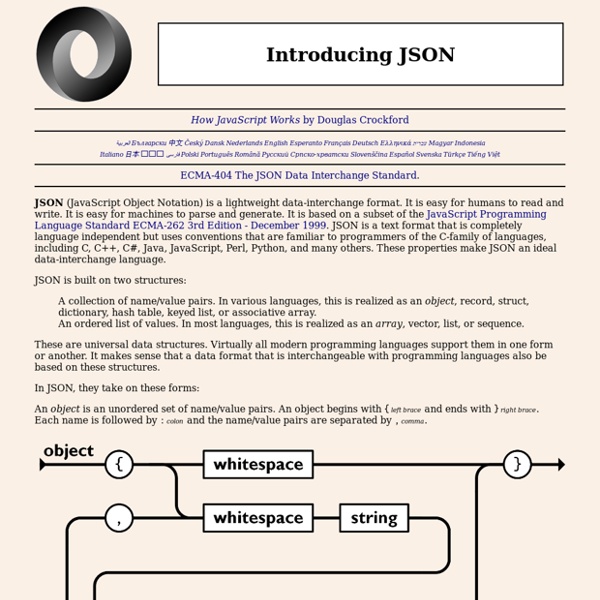



JSON, un format pour échange de données avec JavaScript JSON ( jison ou jayson, jason en anglais) est reconnu par JavaScript, après que l'ECMA ait définit la fonction eval qui parse le format, dans le standard ECMAScript, en 1999. Il a été popularisé par le développement d'Ajax. Le terme JSON revient souvent lorsque l'on parle d'Ajax. JSON vs. Les avantages de JSON: La vitesse de traitement. Les avantages de XML: XML est extensible quand au langage, on peut créer des formats comme RSS, SVG. Noter que XML aussi bien que JSON ne conviennent pas pour stocker directement des données binaires de taille importante. La syntaxe de JSON Les éléments de JSON sont: Un objet: contient d'autres objets ou des variables. L'objet Il contient un membre ou une liste de membres, chaque membre étant de la forme: "nom" : "valeur" La syntaxe de l'objet est: { membre, membre, .... } Le tableau Contient une ou plusieurs valeurs séparées par des virgules. [ valeur, valeur, ....] Les valeurs Et il n'y a besoin de rien de plus à savoir pour créer un fichier JSON! <? Coté client
Sublime Text 2 pour le dev web : config, trucs et astuces • JS Attitude : formations JavaScript qualitatives et sympathiques Pourquoi cet article ? J'écris cet article parce qu'autant ST peut être extrêmement puissant et confortable, autant son installation par défaut (ST « nu », si vous voulez) n'en laisse pas paraître grand chose… La sidebar est totalement dénuée d'options utiles au clic droit, on n'a pas de transpose, etc. Et même ses fonctions natives puissantes, comme le Go To Anything, la Command Palette ou les Layouts, sont souvent bien peu utilisés, ou sous-employés. L'idée est donc de mettre en place ici une config « musclée », et de vous fournir également des liens vers des ressources externes de qualité sur ST lui-même, au travers notamment de screencasts, qui constituent toujours une des meilleures approches pour découvrir un éditeur, car l'aspect visuel et animé est important ici. Je peux affirmer que ces ressources m'ont vraiment permis d'avoir rapidement une utilisation efficace de ST, quelques jours à peine après avoir commencé à l'utiliser. À partir de zéro Installation Killer features
Sproutcore and App Dev In General I’ve been intentionally learning how to develop using Sproutcore for about a month now, so I’ve been more aware of the buzz about it, and I have to say that most things I read are missing the point about the value promise of Sproutcore. The impetus behind my learning is that it is an application development framework for the HTML5/JavaScript platform, versus the Flash Platform that I’m used to developing for. The key here is that it is an application development framework. It is not another DOM access library, widget set, or MVC, and it shouldn’t even be compared to them. It’s not a “Flash-killer“. Flash is just a display technology. I realize that Adobe’s building in support for FlexUnit4 in Flash Builder 4 / Flex 4 SDK which is wonderful. If you look at what Microsoft is doing with Silverlight, they are positioning themselves to own that stack, and not only that, but they have the advantage of not being the first in that they can fix all the things that Adobe has done wrong.
Flexigrid HTML5 Web Workers jQuery Using jQuery To Manipulate and Filter Data When a webpage is designed to display large tables of data, a great amount of consideration should be dedicated to allowing the user to sort through the data in a structured manner. In this article, I will go over four techniques: hover effects, zebra rows, filtering, and sorting. There are some important notes we must address before looking at our Javascript code. The HTML table markup will be like any other table you may have created, except we require two tags that many people omit. The head section of the table must be wrapped in <thead></thead>. Zebra Rows Zebra Rows are a very common data organization technique that are both easy to implement and have a powerful impact. Now on to the actual Zebra Rows. This is fairly trivial; we are telling the table background to be white, and to stretch to 100% of the parent element's width. Here we are setting up a class for the "odd" table rows that sets an alternate background-color and font-color. Hover Effect Filtering Data style.css Wrap Up
Les appels Ajax avec XMLHTTPRequest - Les tutoriaux de Tout JavaScript.com Robloche nous propose ici un tutorial passionnant sur l'utilisation des requêtes serveur en JavaScript. Ce tutorial a été remis à jour en aout 2017 pour tenir compte des évolutions des navigateurs. L'objet XMLHTTPRequest permet de réaliser des appels au serveur depuis la page HTML. Il s'agit d'appels AJAX (Asynchronous JAvascript XML). Présentation Comme leur nom ne l'indique pas, les objets XMLHTTPRequest permettent de récupérer toutes sortes de données, et pas seulement des fichiers XML. > Masquer le code JavaScript var xhr_object = new XMLHttpRequest(); xhr_object.open("GET", location.href, false); xhr_object.send(null); if (xhr_object.readyState == 4) alert("Requête effectuée !") Comment ça marche ? ligne 1 : on crée une instance de l'objet XMLHTTPRequest ligne 2 : on spécifie la méthode de transmission des données, l'URL et le mode de transmission de la requête ; ligne 3 : on exécute la requête proprement dite ; ligne 5 : on affiche une boîte d'alerte dès que la requête est terminée.